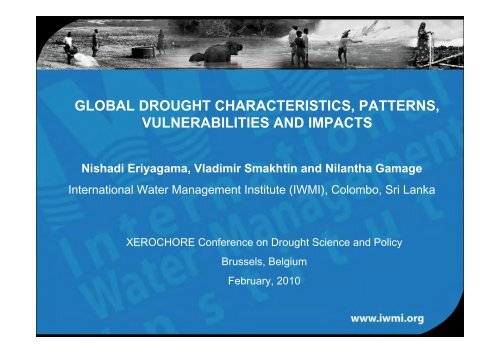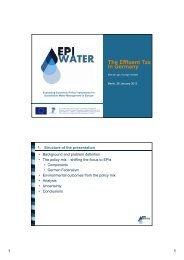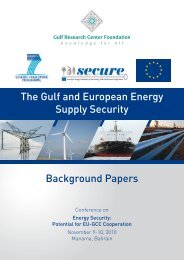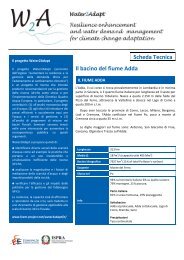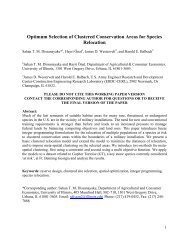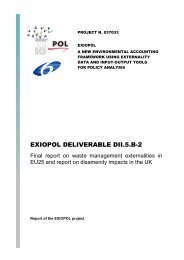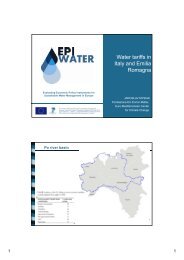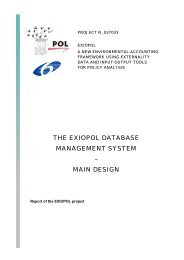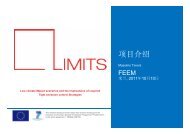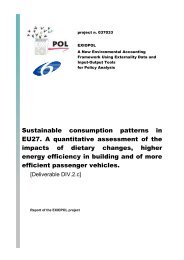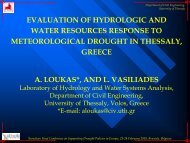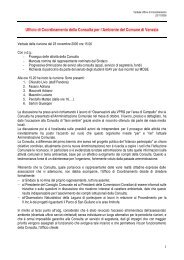global drought characteristics, patterns ... - Feem-project.net
global drought characteristics, patterns ... - Feem-project.net
global drought characteristics, patterns ... - Feem-project.net
Create successful ePaper yourself
Turn your PDF publications into a flip-book with our unique Google optimized e-Paper software.
GLOBAL DROUGHT CHARACTERISTICS, PATTERNS,<br />
VULNERABILITIES AND IMPACTS<br />
Nishadi Eriyagama, Vladimir Smakhtin and Nilantha Gamage<br />
International Water Management Institute (IWMI), Colombo, Sri Lanka<br />
XEROCHORE Conference on Drought Science and Policy<br />
Brussels, Belgium<br />
February, 2010
OBJECTIVE AND RATIONALE<br />
To examine the <strong>global</strong> <strong>patterns</strong> and impacts of <strong>drought</strong>s as an<br />
individual natural disaster<br />
Why?<br />
Affect all world regions<br />
Severe social and economic impacts, especially in<br />
developing countries<br />
Climate change: more frequent, more severe and<br />
longer lasting <strong>drought</strong>s<br />
Studies that map <strong>global</strong> <strong>patterns</strong>, impacts of <strong>drought</strong>s<br />
are limited or non-existent
How?<br />
METHODOLOGY<br />
Mapped 14 <strong>drought</strong> related <strong>characteristics</strong> and indices<br />
Cover various aspects: meteorology, social vulnerability,<br />
<strong>drought</strong> preparedness<br />
At either country scale or a regular grid scale<br />
Produced by integrating about 15 publicly available <strong>global</strong><br />
data sets:<br />
• AQUASTAT (FAO), ProdSTAT (FAO)<br />
• Gridded Population of the World (Columbia University)<br />
• World Register of Dams (International Commission on<br />
Large Dams)
Mean Annual Precipitation<br />
and variability<br />
Socioeconomic Drought<br />
Vulnerability Index<br />
Drought Risk Index<br />
SOME EXAMPLE INDICES<br />
Per Capita Mean Annual<br />
River Discharge<br />
Mean Drought Run Duration<br />
Storage-Drought Duration<br />
Index<br />
Infrastructure Vulnerability<br />
Index<br />
Agricultural Water Crowding<br />
Storage-Drought Deficit Index
MEAN ANNUAL PRECIPITATION,<br />
COEFFICIENT OF VARIABILITY & DROUGHT<br />
Mean Annual<br />
Precipitation<br />
Coefficient of<br />
Variability (CV) of<br />
Mean Annual<br />
Precipitation<br />
Probability (%) of<br />
annual<br />
precipitation in any<br />
year being less<br />
than 75% of its<br />
long term mean<br />
Naturally arid and<br />
semi-arid areas<br />
have higher CV and<br />
higher probability of<br />
<strong>drought</strong> occurrence
Precipitation Drought Risk Index<br />
DROUGHT RISK INDEX<br />
River Discharge Drought Risk Index<br />
Measure of frequency of <strong>drought</strong> occurrence and <strong>drought</strong> intensity<br />
(after Hashimoto et al. 1982 and Zongxue et al. 1998) Range: 0-1<br />
•River discharge <strong>drought</strong> risk higher than precipitation <strong>drought</strong> risk<br />
•Naturally arid and semi arid areas show higher <strong>drought</strong> risk<br />
•Europe: “better-off” Africa: the worst case
STORAGE DROUGHT DURATION INDEX (SLI)<br />
What proportion of the annual hydrological <strong>drought</strong> duration can a<br />
country’s present storage satisfy, based on its monthly water needs<br />
If SLI>=1: Satisfactory Storage (green and blue)
STORAGE DROUGHT DEFICIT INDEX (SDI)<br />
What proportion of the annual hydrological <strong>drought</strong> deficit can a<br />
country’s present storage satisfy, based on its monthly water needs<br />
If SDI>=1: Susceptible to river fragmentation, overexploitation of<br />
freshwater resources (green and blue)
INFRASTRUCTURE VULNERABILITY INDEX<br />
Infrastructure<br />
Vulnerability Index<br />
(0-100)<br />
rural accessibility<br />
improved drinking<br />
water availability<br />
Measure of Anti-<strong>drought</strong> coping capacity
SOCIOECONOMIC DROUGHT VULNERABILITY<br />
INDEX<br />
Socioeconomic<br />
Drought Vulnerability<br />
Index<br />
(0-100)<br />
Percentage employed in<br />
agriculture<br />
Share of agricultural GDP<br />
Crops diversity<br />
Measure of dependence on agriculture and diversity of crops
SOME KEY MESSAGES (1)<br />
• Naturally arid and semi-arid areas: higher probability of <strong>drought</strong><br />
occurrence<br />
• Generally river discharge <strong>drought</strong> risk is higher than precipitation<br />
<strong>drought</strong> risk<br />
• Areas more prone to multi-year hydrological <strong>drought</strong>s: Majority of<br />
Africa; South, Southwest, Central Asia; and northern Australia<br />
• Out of them, Australia and southern Africa appear to have sufficient<br />
storage to satisfy their water needs during <strong>drought</strong><br />
• South and Central Asia have no apparent hydrological barriers for<br />
increasing storage in the future
SOME KEY MESSAGES(2)<br />
• In <strong>drought</strong> years the highest per capita water losses occur in areas<br />
which are not normally water scarce due to climate<br />
• Potential for rainwater use in agriculture which could be tapped with<br />
increased rainwater harvesting<br />
• Agricultural economies (Asia and Africa) are much more vulnerable to<br />
adverse societal impacts of meteorological <strong>drought</strong>s<br />
• The African continent lags behind the rest of the world on many<br />
indicators related to <strong>drought</strong> preparedness
CONCLUSIONS AND THE WAY FORWARD<br />
• It is hoped that this study may:<br />
• develop into a Global Drought Indicators ‘Atlas’<br />
• feed into operational <strong>drought</strong> tools (<strong>drought</strong> monitoring, <strong>drought</strong> early<br />
warning systems) and national <strong>drought</strong> preparedness plans<br />
• Future research should concentrate on:<br />
• quantifying and indexing vulnerability to <strong>drought</strong>s within countries and<br />
at local and household levels to identify vulnerable regions or<br />
populations<br />
• the differences between short term and long term <strong>drought</strong>s (impacts<br />
and response options)<br />
• identifying how some of the mapped indices might change with<br />
climate change
THANK YOU!


